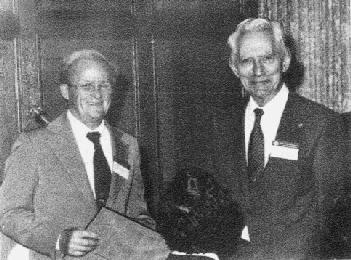
582650 Information-Theoretic Modeling (4 cr)
Department of Computer Science, University of Helsinki
An advanced course in the Algorithms and Machine Learning
sub-programme. Students in other programmes, as well as students
in mathematics and statistics are welcome too.
This course provides an introduction to information theory from the
computer science perspective. Much of the course can be viewed as
consequences of Shannon's central result known as the Noiseless Source
Coding Theorem. The theoretical results will be illustrated by various
practical data compression systems from Huffman coding
to Rissanen's arithmetic coding. In order to demonstrate the wide
applicability of information-theoretic concepts in intelligent
systems, we discuss information-theoretic principles in statistical
modeling, and especially the Minimum Description Length (MDL) principle.
|
- Lecturer
- Teemu Roos, A332,
teemu.roos at cs.helsinki.fi
- Teaching assistant
- Anupam Arohi, anupam.arohi at cs.helsinki.fi
Language: All course material and lectures will be in English.
Lectures: Period I: 8.9.–16.10. Tue & Fri 10–12 in C222 (except 25.9. in CK112). All the lectures will be recorded on video and made available the following day.
Exercises: 18.9.–16.10. Fri 12–14 in C222.
Final exam: Tue 20.10. 9-12AM in B123
The course is followed by a related project in Period II. It is recommended that you take both the course and the project. (More information will be posted later.)
Prerequisites:
- Elementary calculus (limits and convergence, convexity)
- Basic probability (random variables, conditional and joint distributions, expectation)
- Good programming skills (no specific language required)
Contents
The schedule below is tentative and subject to change.If you don't have a high-speed connection, you may prefer the downloadable versions of the videos.
- Lecture 1. (Tue 8.9.)
- Introduction.
participation obligatory
• introduction to the course • overview of contents
 slides
slides
 video
video
 exercises #1
exercises #1
- Lecture 2. (Fri 11.9.)
- Noisy Channel Coding.
• error correcting codes • noisy channel coding theorem • Hamming codes
 slides
slides
 video
video
- Lecture 3. (Tue 15.9.)
- Mathematical Preliminaries.
• calculus • probability • law of large numbers • Jensen's and Gibbs' inequalities
 slides
slides
 video
video
 exercises #2 |
files
exercises #2 |
files
- Lecture 4. (Fri 18.9.)
- Source Coding: Theory.
• entropy and information • asymptotic equipartition property (AEP) • noiseless source coding theorem
 slides
slides
 video
video
- Lecture 5. (Tue 22.9.)
- Source Coding: Practice.
• symbol codes • Kraft inequality • entropy coding
 slides
slides
 video
video
 exercises #3
exercises #3
- Lecture 6. (Fri 25.9.)
- Special Guest Lecture: Daniel Schmidt
• Minimum Message Length (MML) principle
 slides
slides
 video
video
- Lecture 7. (Tue 29.9.)
- Source Coding: Practice (contd.).
• Shannon-Fano code • Huffman code • arithmetic coding
 slides
slides
 video
video
 exercises #4
exercises #4
- Lecture 8. (Fri 2.10.)
- Universal Source Coding.
• two-part codes • mixture codes • normalized maximum likelihood
 slides
slides
 video
video
- Lecture 9. (Tue 6.10.)
- MDL Principle.
• Occam's razor • old-style & modern MDL
 slides |
more slides
slides |
more slides
 video
video
 exercises #5 |
data
exercises #5 |
data
- Lecture 10. (Fri 9.10.)
- MDL Principle (contd.).
• example applications
 slides
slides
 video
video
- Lecture 11. (Tue 13.10.)
- Further Topics
• Kolmogorov complexity • gambling • lossy coding • etc.
 slides
slides
 video
video
- Lecture 12. (Fri 16.10.)
- Redundant Lecture
• summary of course contents • questions and answers before final exam • introduction to project
 video
video
Additional Material (by Lecture)
Here you can find recommended (but not required) additional material, categorized according to (our) lectures.- Lecture 2. Noisy Channel Coding
-
- Information and Entropy
- an MIT OpenCourseWare elementary level course •
for material by topic, click here
⇒ material on noise and errors
- Lecture 4. Source Coding: Theory
-
- Cover & Thomas, Elements of Information Theory, Chapter 2
- (see course folder, C127)
- Claude E. Shannon, "A mathematical theory of communication", The Bell Systems Technical Journal, Vol. 27, pp. 379–423, 623–656, July-October, 1948.
- ⇒ a reprint (with corrections) from Bell Labs
- Joaquin Candela, Probability, Information Theory and Bayesian Inference, on videolectures.net
- • part 1: probability
- • parts 2 & 3: entropy and information
- • part 4: Bayesian inference
- Lectures 5 & 7. Source Coding: Practice
-
- Witten, Neal & Cleary, "Arithmetic coding for data compression", Communications of the ACM, Vol. 30, No 6, pp. 520–540, 1987.
- Cover & Thomas, Elements of Information Theory, Chapter 5
- (see course folder, C127)
- Lelewer & Hirschberg, "Data compression", ACM Computing Surveys, Vol. 19, No. 3, pp. 261–296, 1987.
- Ken Huffman, "Huffman algorithm", Huffman Coding Blog, Dec. 24, 2008.
- a mostly informal blog entry written by David Huffman's nephew &bull relates Huffman code to mobiles (no, not cell phones)
- David Solomon, Data Compression: The Complete Reference, Springer, 2004, 926 pages
- the title says it all: a comprehensive reference; more recent editions available
- Lecture 6. Minimum Message Length Principle
-
- Lloyd Allison, Minimum Message Length, web resource
- brief introduction to basic ideas • many useful links
- Lecture 8: Universal Source Coding
-
- Peter Grünwald, The Minimum Description Length Principle, MIT Press, 2007, 504 pages
- • part 2: universal coding
- Lectures 9 & 10: MDL Principle
-
- Peter Grünwald, The Minimum Description Length Principle, MIT Press, 2007, 504 pages
- • chapter 1: learning, regularity, and compression
⇒ PDF available - Peter Grünwald, MDL Tutorial, on videolectures.net
- Jorma Rissanen, Minimum Description Length Principle, Scholarpedia, 3(8):6727.
- Kontkanen & Myllymäki, "A linear-time algorithm for computing the multinomial stochastic complexity", Information Processing Letters, Vol. 103, No. 6, pp. 227–233, 2007.
- a simple yet very useful result • quite complex proof
- Lecture 11: Further Topics
-
- Li & Vitanyi, Kolmogorov Complexity and Its Applications, Springer, 1997.
- the book about Kolmogorov complexity
- John L. Kelly, Jr., "A new interpretation of information rate", Bell Systems Technical Journal, Vol. 35, pp. 917–926, 1956.
- ⇒ PDF available
- Video Coding Fundamentals & H.264, blog
- •
image coding
• video coding

|
|
September 8 First lecture (C222); participation obligatory.
September 9 Video of first lecture and first set of exercises available (see Contents below). September 18 First exercises (C222). September 25 We have a special guest lecturer, Dr. Daniel Schmidt, who talks about the Minimum Message Length (MML) principle. Note changed room: CK112. October 20, 9-12AM Final exam, B123. November 20, 16-20PM Separate exam in case you missed or failed the first one, A111. |
